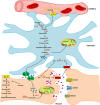The potential mechanisms of lactate in mediating exercise-enhanced cognitive function: a dual role as an energy supply substrate and a signaling molecule
- PMID: 35907984
- PMCID: PMC9338682
- DOI: 10.1186/s12986-022-00687-z
The potential mechanisms of lactate in mediating exercise-enhanced cognitive function: a dual role as an energy supply substrate and a signaling molecule
Abstract
Lactate has previously been considered a metabolic waste and is mainly involved in exercise-induced fatigue. However, recent studies have found that lactate may be a mediator of the beneficial effects of exercise on brain health. Lactate plays a dual role as an energy supply substrate and a signaling molecule in this process. On the one hand, astrocytes can uptake circulating glucose or degrade glycogen for glycolysis to produce lactate, which is released into the extracellular space. Neurons can uptake extracellular lactate as an important supplement to their energy metabolism substrates, to meet the demand for large amounts of energy when synaptic activity is enhanced. Thus, synaptic activity and energy transfer show tight metabolic coupling. On the other hand, lactate acts as a signaling molecule to activate downstream signaling transduction pathways by specific receptors, inducing the expression of immediate early genes and cerebral angiogenesis. Moderate to high-intensity exercise not only increases lactate production and accumulation in muscle and blood but also promotes the uptake of skeletal muscle-derived lactate by the brain and enhances aerobic glycolysis to increase brain-derived lactate production. Furthermore, exercise regulates the expression or activity of transporters and enzymes involved in the astrocyte-neuron lactate shuttle to maintain the efficiency of this process; exercise also activates lactate receptor HCAR1, thus affecting brain plasticity. Rethinking the role of lactate in cognitive function and the regulatory effect of exercise is the main focus and highlights of the review. This may enrich the theoretical basis of lactate-related to promote brain health during exercise, and provide new perspectives for promoting a healthy aging strategy.
Keywords: Astrocyte-neuron metabolic coupling; Cognitive function; Exercise intervention; Lactate receptor HCAR1/GPR81; Lactate shuttle.
© 2022. The Author(s).
Conflict of interest statement
The authors declare that they have no competing interests.
Figures



Similar articles
-
Cellular mechanisms of brain energy metabolism and their relevance to functional brain imaging.Philos Trans R Soc Lond B Biol Sci. 1999 Jul 29;354(1387):1155-63. doi: 10.1098/rstb.1999.0471. Philos Trans R Soc Lond B Biol Sci. 1999. PMID: 10466143 Free PMC article. Review.
-
Lactate Metabolism, Signaling, and Function in Brain Development, Synaptic Plasticity, Angiogenesis, and Neurodegenerative Diseases.Int J Mol Sci. 2023 Aug 29;24(17):13398. doi: 10.3390/ijms241713398. Int J Mol Sci. 2023. PMID: 37686202 Free PMC article. Review.
-
Exercise Counteracts Aging-Related Memory Impairment: A Potential Role for the Astrocytic Metabolic Shuttle.Front Aging Neurosci. 2016 Mar 22;8:57. doi: 10.3389/fnagi.2016.00057. eCollection 2016. Front Aging Neurosci. 2016. PMID: 27047373 Free PMC article. Review.
-
The Strategic Location of Glycogen and Lactate: From Body Energy Reserve to Brain Plasticity.Front Cell Neurosci. 2019 Mar 6;13:82. doi: 10.3389/fncel.2019.00082. eCollection 2019. Front Cell Neurosci. 2019. PMID: 30894801 Free PMC article.
-
The lactate receptor, G-protein-coupled receptor 81/hydroxycarboxylic acid receptor 1: Expression and action in brain.J Neurosci Res. 2015 Jul;93(7):1045-55. doi: 10.1002/jnr.23593. Epub 2015 Apr 16. J Neurosci Res. 2015. PMID: 25881750 Review.
Cited by
-
Astrocyte metabolism and signaling pathways in the CNS.Front Neurosci. 2023 Sep 4;17:1217451. doi: 10.3389/fnins.2023.1217451. eCollection 2023. Front Neurosci. 2023. PMID: 37732313 Free PMC article. Review.
-
The role of efferocytosis-fueled macrophage metabolism in the resolution of inflammation.Immunol Rev. 2023 Oct;319(1):65-80. doi: 10.1111/imr.13214. Epub 2023 May 9. Immunol Rev. 2023. PMID: 37158427 Free PMC article. Review.
-
An Energy-Efficient Flexible Multi-Modal Wireless Sweat Sensing System Based on Laser Induced Graphene.Sensors (Basel). 2023 May 17;23(10):4818. doi: 10.3390/s23104818. Sensors (Basel). 2023. PMID: 37430732 Free PMC article.
-
A monocarboxylate transporter-dependent mechanism confers resistance to exercise-induced fatigue in a high-altitude hypoxic environment.Sci Rep. 2023 Feb 20;13(1):2949. doi: 10.1038/s41598-023-30093-1. Sci Rep. 2023. PMID: 36807596 Free PMC article.
-
The Adrenal Pheochromocytoma Cell Line PC12 Efficiently Promotes the Regeneration Capability of Adipose Tissue-Derived Mesenchymal Stem Cells in Myogenesis: A Particular Approach to Improving Skeletal Muscle Cell Regeneration.Iran J Med Sci. 2024 Sep 1;49(9):590-603. doi: 10.30476/ijms.2023.99642.3175. eCollection 2024 Sep. Iran J Med Sci. 2024. PMID: 39371379 Free PMC article.
References
-
- Brooks GA. Lactate: glycolytic end product and oxidative substrate during sustained exercise in mammals—the ‘lactate shuttle’. In: Gilles R, editor. Circulation, Respiration, and Metabolism: Current Comparative Approaches. Berlin: Springer-Verlag Press; 1985. pp. 208–218.
-
- Todd JJ. Lactate: valuable for physical performance and maintenance of brain function during exercise. Biosci Horizons. 2014;7:hzu001–hzu001. doi: 10.1093/biohorizons/hzu001. - DOI
Publication types
Grants and funding
LinkOut - more resources
Full Text Sources

